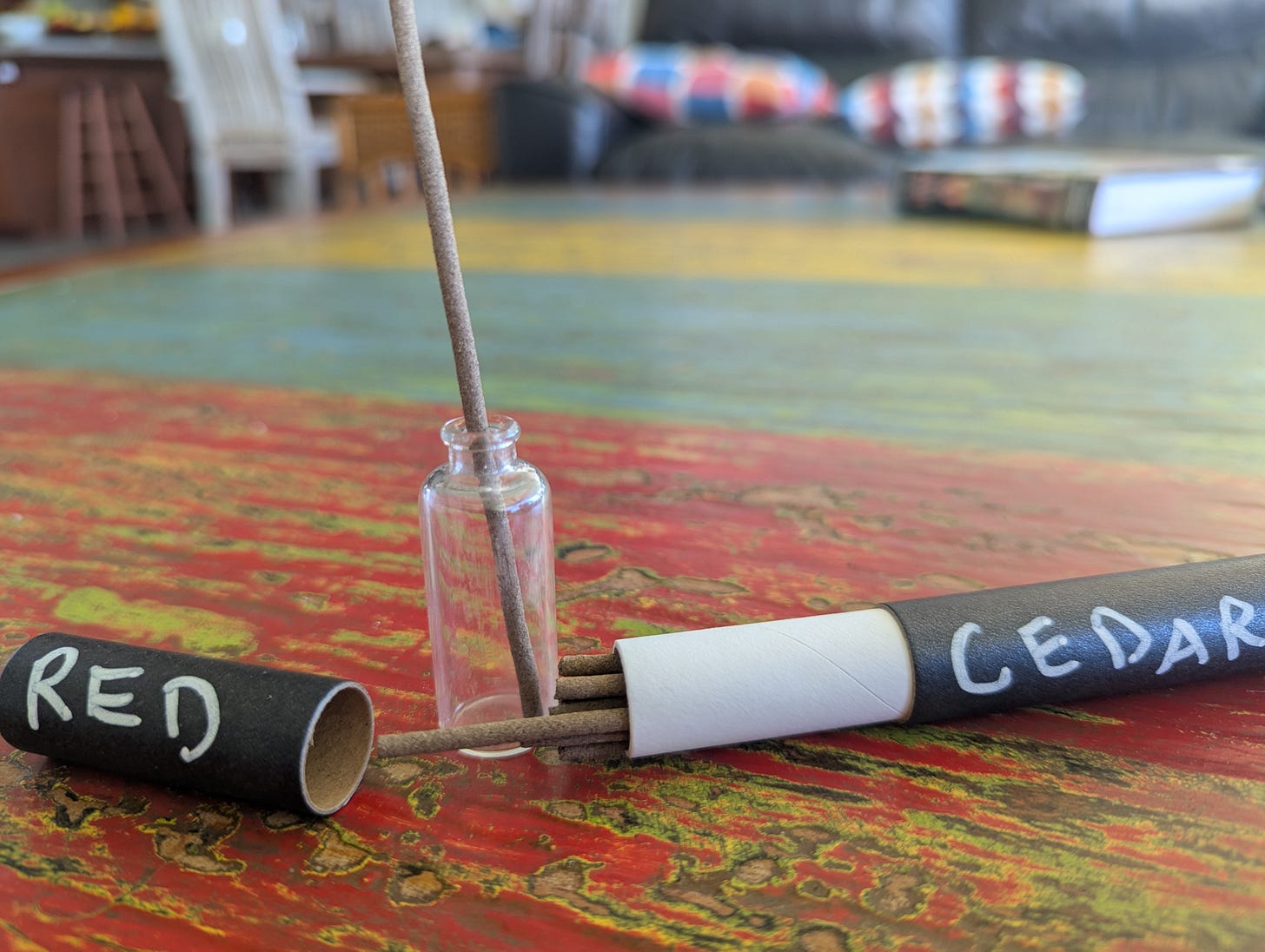What is an artist? To me, being an artist means having an irresistible compulsion to make stuff regardless of its potential profit or usability. I can safely call myself an artist, then, because I’ve been making more incense than I could ever use. (I hope you like incense, friends! Because you’re getting some!) I just love the process of making it, and lately, I’ve felt increasing confidence in creating my own blends as well as using new-to-me tools and ingredients.
Playing with Molds
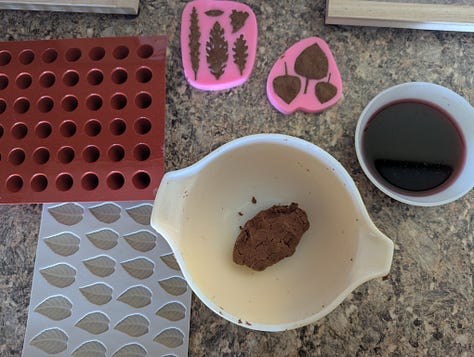
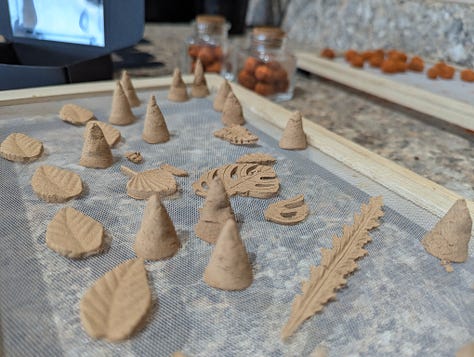
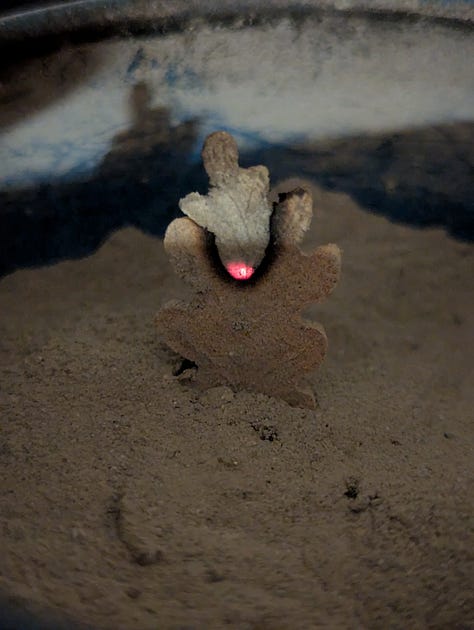
My very favorite Daddy Carl recipe is a simple blend of Australian sandalwood, valerian root, red wine, and gum binder. I love how the sweetness of sandalwood softens the medicinal, earthy funk of valerian, which (along with mugwort) is one of my favorite herbs to use in incense. I made an extra big batch last month so I could play with a bunch of new silicone molds I got for Christmas. The big wins were the leaf-shaped molds, which were thin and shallow enough to make incense leaves that were not only beautiful, but burned consistently. Unfortunately, some of these were extremely delicate and liable to break, which makes shipping them problematic. I was disappointed in the cone-shaped molds, as these not only took forever to dry, but resulted in cones that were too fat to burn well. Yet again, I’ve learned that to get the best cones, I have to roll them myself.
Nerikoh Experiments
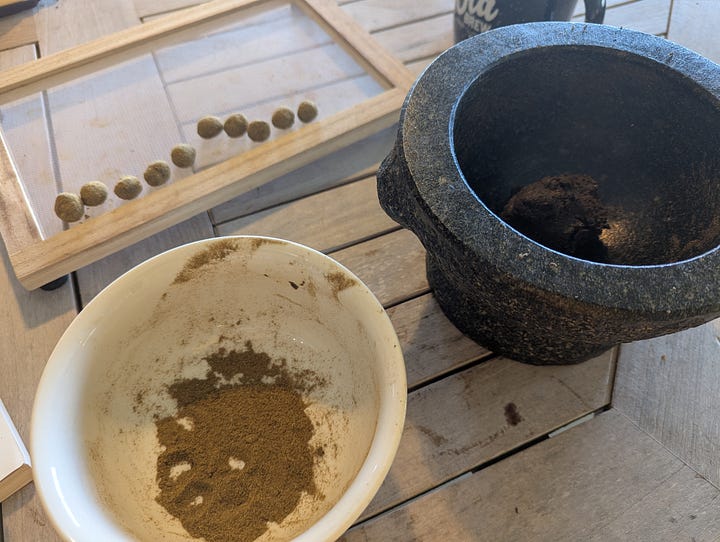
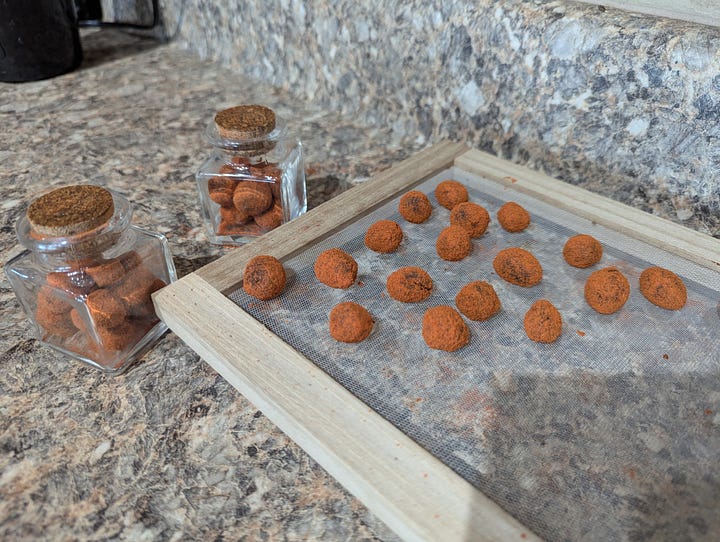
One of my favorite incense books is The Complete Incense Book by Susanne Fischer-Rizzi. I adore its luscious illustrations and pictures, and I really love how she organizes her incense recipes by their country of origin. I envision working my way through the entire book, taking a trip around the world via scent alone. However, all her recipes are for loose blends to be burnt over charcoal, which are a no-no for me since my lungs are still sensitive from my incense binges last year. Thus I liberally adapted a couple of her recipes into nerikoh, using the ratio Persephenie taught me.
I started first with one of Fischer-Rizzi’s prehistoric, Pleistocene-themed blends called Lupuleda: a mix of pine bark, pinon resin, frankincense, marsh labrador, hops, pine needles, and juniper berries. For my nerikoh, I nixed the frankincense, increased the pinon, and used whole dried juniper berries that were soaked in red wine as well as powdered, dried berries and a more or less equal amount of hops, marsh labrador, and pine needles. My hope was that it would smell like a Neanderthal’s campfire in a pine forest. While it’s better for nerikoh to age and ferment for a while, it can be used on a warmer right away, so I threw one on as soon as I could. The result didn’t smell like much of anything. Aging them a couple of weeks brought out more of the hops aroma, but they were still too subtle for my taste. We’ll see if a few more months of fermentation improves them.
My chief mistake was not testing the ingredients on a charcoal before rolling them into nerikoh. Despite my lungs’ protests, I did this after I made the Lupuleda nerikoh so I could better understand each of the ingredients’ scent profile. This was where I learned the drawbacks of working with herbs purchased on the cheap from Amazon or from random vendors on Etsy. (I’ve had better luck with stuff purchasedz from Mountain Rose Herbs and Scents of Earth, herb and incense specialists.) Surprisingly, the pine bark and needles had barely any smell at all when burned. I’m guessing this is because they’re not very fresh. Who knows how long some of these sat on a shelf before they got to me? The only ingredients with aromas stout enough for me were the hops and pinon resin, and while I enjoy hops in my beer, I don’t like them in incense. Burning hops smell too much like cannabis, and I don’t need to torture myself with that. At least this experiment proved to me the importance of gathering and drying my own herbs instead of buying them online. It’s the only way to guarantee freshness.
More successful was my riff on a recipe from the Japan chapter called Night Leaves, a combination of sandalwood, labdanum, storax, frankincense, and cinnamon. Since I was running low on sandalwood, I made up the difference with yohimbe, a bark with a very mild, coffee-like aroma. I rolled the nerikoh in red sandalwood, which gave it a festive color that matched the reddish aroma of cinnamon. These were sweet and lovely right away, and they’ve only gotten better with aging. It’s almost impossible to go wrong with cinnamon.
Pom as a Joss Stick
My friend Grace had a birthday coming up. I’d given her a sampler of the incenses I’d made with Persephenie for Christmas, and her favorite of the bunch was the pom. I was itching to try my hand at making more joss sticks, so I decided to adapt the pom into combustible stick form as a gift for her. Using Persephenie’s self-combusting incense ratio, I combined red cedar, tonka bean, and copal negro with makko, a mucilaginous bark that serves as the base for many Japanese incenses. It’s too bad that I have to limit my burning of self-combusting incense, because working with makko is such a dream! I could make makko-based incense all freaking day! It makes a dough that is wonderfully easy to work via extruder, molds, or hand-rolled cones. I’m very proud of how the joss sticks came out, and they smell fantastic: deeply Mesoamerican, warm and funky and comforting. Alas, makko irritates my lungs, so my cache of pom-as-josses will all go to friends. If you’re reading this and haven’t tried any of my incenses yet, ping me and I’ll mail you some!
As a work friend’s birthday was coming up, I planned to give her some of the pom-as-stick, too, but I had run out of extra incense holders. I unexpectedly discovered a new, cheap, and interesting source of incense holders at Glass from the Past, the local junk store that has been a treasure trove of finds. Because Big Island didn’t start recycling glass until the 80s, glass was simply buried along with other household trash. Glass from the Past’s owner digs through these middens (some of which are 80-90 years old), cleans up his finds, and offers them for sale at his shop. Thus you can find opaque white cold cream jars, gorgeous deep blue medicine vials, and vintage Coke bottles in his shop, all from a time before plastic was the default container for all things. This past weekend, the owner’s wife showed me a cache of the teeniest, tiniest little medicine bottles from the 30s and 40s, all for a few bucks each. My joss sticks are too fat for most typical incense holders, so these little bottles were perfect.
What’s next? Perhaps that gum you like will come back in style…
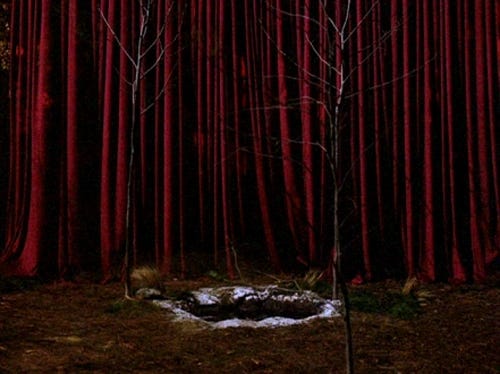
After these experiments, I went back to practicing joss sticks with Daddy Carl recipes, giving my brain a rest and my hands a break from making sticky, messy nerikoh. During that time, David Lynch passed away just before his 79th birthday. I’ve been a fan of his for years, so this sad news sent me reeling back into the world of Twin Peaks. To honor him, I plan to rewatch all 3 seasons plus Fire Walk with Me over the next few months. This has sparked an obsession with making nerikoh that embodies the smell of Twin Peaks. I’ve started researching and gathering ingredients, so watch this space for more to come.
Thanks for reading, friends.


